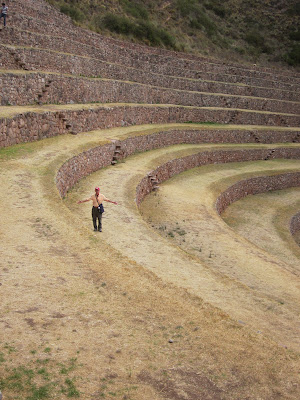






 Just outside of the crossroad village of Urubamba are two Incan curiosities: Moray and Salinas. We caught a bus to an intersection about 10 miles out of town, got off the bus and hired a taxi to take us another 8 miles to Moray. Think of Moray as the Agricultural Extension Service of the Incans. These three depressions close to each other in the high desert are thought to be experimental plant labs. Researchers have found crop seeds on the terraces dating to the fifteenth century. Makes sense to me: each terrace is in a different micro climate, the amount of sun differs from one side of the circle to the other side, the amount of water from run-off differs on each level.
Just outside of the crossroad village of Urubamba are two Incan curiosities: Moray and Salinas. We caught a bus to an intersection about 10 miles out of town, got off the bus and hired a taxi to take us another 8 miles to Moray. Think of Moray as the Agricultural Extension Service of the Incans. These three depressions close to each other in the high desert are thought to be experimental plant labs. Researchers have found crop seeds on the terraces dating to the fifteenth century. Makes sense to me: each terrace is in a different micro climate, the amount of sun differs from one side of the circle to the other side, the amount of water from run-off differs on each level. Again, the engineering is marvelous. The steps are cantilevered in the terrace walls, and each level is more than head-high. The day we were there was stormy, normal for that time of year. Where Stuart is standing would have been planted with potatoes, corn, quinoa, fruits or other vegetables.
The taxi driver drove us through the dry pastures past many small herds of sheep, about 15 miles, to the tiny village of Salinas. Another Incan engineering curiosity. Salinas, a form of the word for salt, is a mile-long series of salt pools, fed by a spring higher up the mountain. There were hundreds of salt pools! Each one is managed by a family who's roots trace several centuries in this area. They collectively mine and sell the salt from these pools, passing along ownership that reads like a well-detailed family tree. The paths between the pools are as much as foot thick with salt accumulation, not more than a foot-print wide. The pools vary in depth from a few inches to more than 2 feet deep. We were there on a holiday, we saw only one pool being worked. Two women, both barefoot, were raking and bagging the salt from their family pool.
The view from the top was beautifully white, and even on this gray day was blindingly bright. It took us one hour to hike through the pools, and out at the end of the valley. We continued hiking for another couple of hours, back out to the highway, where we waited a very short time for a bus back to Urubamba.
We planned our route to Machu Pichu to begin with time in the Sacred Valley, to get a little understanding of the history of the Incans. Today, we passed young children, maybe 5 years old in the high valley, in charge of the family sheep. We saw houses and other buildings that looked to be as old as the rocks, walked through a village that was locked from the road by the Urubamba River, accessible only by a foot bridge. We walked past a house being built using lumber, pretty rare here. The lumber being cut with a chainsaw. There was no electricity, but gas is available. Most structures are either stone or cement, two materials that are cheap and available.
Tomorrow, we'll travel by bus to Ollantaytambo, and buy a train ticket to Aquas Calientes, and then buy another bus ticket for the final 5 miles to Machu Pichu.

No comments:
Post a Comment